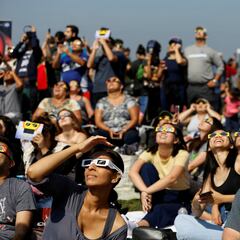Why is it dangerous to look directly at a solar eclipse?
On Saturday, October 14, six states will be able to view a solar eclipse. Learn what precautions to take to look at this astronomical phenomenon safely.

On Saturday, October 14, a unique astronomical phenomenon will take place: an annular solar eclipse. For one hour of the day, the sky will darken as if it were night due to this.
The path of the annular solar eclipse will begin in Oregon and end in the state of Texas, passing through multiple states.
READ ALSO: How and where to see the ‘ring of fire’ eclipse this weekend
On Saturday, October 14, most skywatchers in the U.S. will experience at least a partial eclipse. BUT, from the Oregon coast to the Texas Gulf Coast, where skies are clear, folks will see the full annular eclipse.
— US Department of the Interior (@Interior) October 6, 2023
Photo by Patrick Myers / NPS pic.twitter.com/EhPYiKuDbm
What is a solar eclipse?
According to NASA, an eclipse happens when a planet or moon gets in the way of sunlight. On Earth, two types of eclipses can be observed: solar and lunar, each with particular characteristics.
A solar eclipse happens when the moon gets in the way of light from the sun to the earth. Because of this, the sky goes dark for a few hours while a special light is projected. This phenomenon can happen partially or completely.
When a partial eclipse happens, the moon blocks only part of the path of sunlight. This means that daylight is affected, but not completely darkened. These types of eclipses are more frequent and can occur up to twice a year.
In a total eclipse the moon completely covers the sunlight that should reach the earth. This means that for a few hours the earth is left in darkness. This phenomenon is less frequent and can occur every year and a half. However, whether you can see it or not will depend on your location.
READ ALSO: Which 13 states will see the total eclipse in 2024?
Why is it dangerous to look directly at a solar eclipse?
According to the American Academy of Ophthalmology, it is generally dangerous to look at direct sunlight. However, during an eclipse, this risk increases since upon noticing a decrease in the amount of solar rays, the eyelids do not respond in time to avoid injury to the retina.
Related stories
Looking directly at the sun, even for a short period of time without having the correct protection, can permanently damage the retina. It can even cause total vision loss, known as solar retinopathy. Some symptoms of this condition are decreased visual acuity, headaches and changes in eyesight such as seeing spots.
The only way to safely view an eclipse is to use special solar filters for this purpose that must comply with ISO 12312-2 standards. The AAO warns that regular sunglasses, even the darkest ones, or homemade filters are not safe for viewing the sun.

